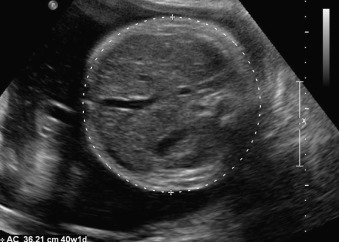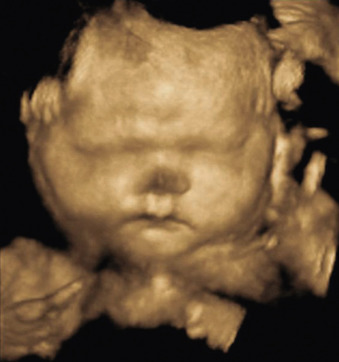Abstract
Macrosomia describes a fetus or neonate with excessive growth. Many factors can influence why macrosomia occurs. Regardless of the etiology, this condition represents increased risk to the mother and fetus during labor and birth. Ultrasound remains the standard for evaluating fetal growth in utero . Prenatal counseling is recommended when macrosomia is diagnosed.
Key Words
macrosomia, large for gestational age, shoulder dystocia, birth injury
Introduction
The term macrosomia is used to describe a fetus or neonate with excessive growth. However, during pregnancy, as the fetus cannot be weighed directly, the term fetal macrosomia is intended to convey a suspicion of excessive fetal growth beyond a specified threshold, based on indirect assessment such as physical examination or ultrasound (US) assessment. Because of the increased risk of labor dystocia, birth trauma, and permanent injury to the fetus with increasing birth weight, being able to determine an accurate estimated fetal weight may affect the mode of delivery. The finding of fetal macrosomia may require additional screening and counseling before delivery.
Disorder
Definition
While the terms large for gestational age (LGA) and fetal macrosomia are both meant to convey a concern for excessive growth, the two terms differ slightly in their specific definitions. LGA refers to neonatal birth weight larger than the 90th percentile for a given gestational age. In contrast to LGA, fetal macrosomia is defined as an absolute birth weight above a specified threshold regardless of gestational age. Varying thresholds have been used, including 4000 g and 4500 g, and both thresholds have been associated with adverse pregnancy outcomes. The American College of Obstetricians and Gynecologists suggests a threshold of 4500 g for considering changes in management, secondary to estimated fetal weight for women with diabetes, and a threshold of 5000 g for women without diabetes.
Prevalence and Epidemiology
The prevalence of macrosomia depends on the definition used and the population studied. In the United States in 2014, 6.9% of neonates weighed more than 4000 g, 1% weighed more than 4500 g, and about 0.1% of neonates weighed more than 5000 g.
Etiology, Pathophysiology, and Embryology
Fetal macrosomia is a description of excessive fetal size. In many cases, it represents a consequence of a multitude of differing environmental and genetic factors that ultimately result in the macrosomic state. Multiple risk factors contribute to fetal macrosomia, some of which are discussed subsequently. Risk factors include:
- 1.
Maternal obesity, defined as a prepregnancy body mass index greater than 30, and excessive gestational weight gain are two important risk factors for macrosomia given the high prevalence of both in the United States.
- 2.
Maternal diabetes and gestational diabetes are well-recognized risk factors for macrosomia because chronic and intermittent maternal hyperglycemia has been strongly associated with accelerated fetal growth and fat deposition. Abnormal glucose tolerance without the diagnosis of gestational diabetes has even been suggested to increase the risk of macrosomia. Management of gestational diabetes with glucose monitoring, nutritional consultation, and hypoglycemic agents, when indicated, significantly mitigates this risk.
- 3.
Postterm pregnancy is a risk factor. In the United States, after 42 weeks’ gestation, 25.3% of fetuses weigh more than 4000 g, and 5.2% weigh more than 4500 g.
- 4.
Genetic syndromes are rare in fetuses with macrosomia without other findings but must be considered, especially when other congenital abnormalities are identified (see Differential Diagnosis From Imaging Findings ).
- 5.
Other important risk factors are multiparity, prior macrosomic infants, male sex, ethnicity, maternal birth weight greater than 4000 g, and advanced maternal age.
Manifestations of Disease
Clinical Presentation
Fetal macrosomia may be present without any maternal clinical manifestations and is commonly identified on physical examination or screening US. Both fundal height measurements and Leopold maneuvers are commonly used to estimate fetal size, but both methods have poor sensitivity and specificity for macrosomia. Fetal macrosomia may be identified on routine screening US during pregnancies with risk factors or as an adjunct to a concerning physical examination. However, some data suggest similar accuracy between US and Leopold maneuvers for predicting macrosomia. Nevertheless, identifying macrosomic fetuses is important given the implications on fetal and maternal pregnancy outcomes.
Fetus and Neonate.
Perinatal outcomes for macrosomic fetuses differ from smaller fetuses, with an increased risk of perinatal death and birth trauma. This is a global phenomenon.
Shoulder dystocia and subsequent birth injuries are a consequence of increasing fetal weight. In fetuses weighing more than 4500 g, the risk for shoulder dystocia is 9% to 24% among nondiabetic mothers, and 19% to 50% in diabetic mothers. Both clavicular fractures and brachial plexus injuries are more commonly identified in macrosomic neonates after a vaginal delivery. Additional neonatal risks include many conditions that are common to infants of diabetic mothers, including hypoglycemia, polycythemia, and metabolic and electrolyte abnormalities.
Mother.
There are significant maternal implications that are strongly associated with macrosomic fetuses, including postpartum hemorrhage and subsequent transfusion, perineal trauma, especially third-degree and fourth-degree lacerations after a vaginal birth, infection, and cesarean birth.
Imaging Technique and Findings
Ultrasound.
Two-dimensional (2D) US coupled with physical examination is the current standard for estimating fetal weight and identifying fetal macrosomia. Fetal weight cannot be directly measured. There are multiple formulas to predict fetal weight based on several biometric measurements, such as femur length, abdominal circumference, and head circumference/biparietal diameter ( Fig. 108.1 ). For diagnosing fetal macrosomia, performing US as near to delivery as possible appears to be more accurate for diagnosis.

Of the multiple formulas for estimating fetal weight, no single one is universally used. A review of different US experiences showed a concerning wide range of sensitivity (12% to 75%), specificity (68% to 99%), and posttest probability (17% to 79%) for identifying macrosomia, highlighting the limitations of US for identifying macrosomia. The value of US may be in its ability to rule out macrosomia rather than confirmation. More recently, greater attention has been directed toward using three-dimensional (3D) US techniques to better predict fetal weight ( Fig. 108.2 ). Although some investigators have found greater accuracy with 3D techniques, at present, there is no evidence to abandon 2D US evaluations.











